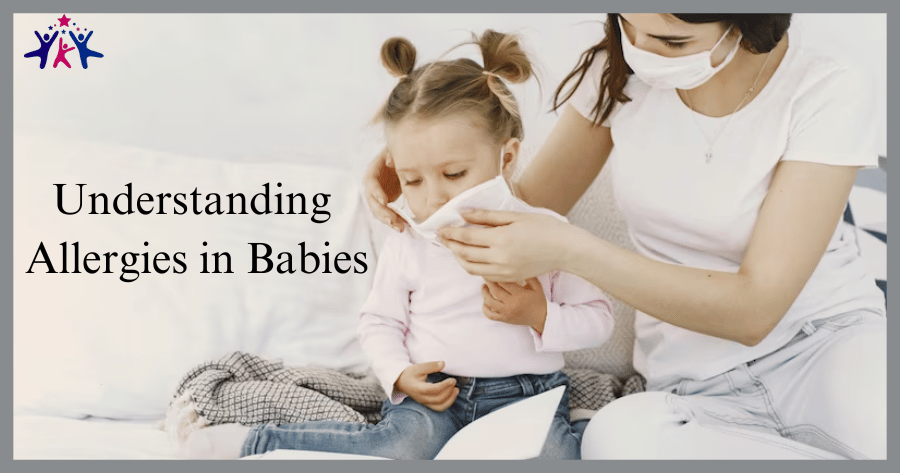As your little one embarks on their exciting journey into the world of solid foods, you might be wondering about food allergies. Fear not! We’ve got you covered with this guide to understanding common food allergies in babies and how to control them. Let’s dive in and conquer the allergy maze together!
Understanding allergies in babies is crucial for parents and caregivers to ensure the well-being of their little ones. Allergies can manifest in various forms, and being aware of the signs and symptoms is essential for early detection and effective management.
Common Culprits: Top Food Allergens for Babies
The Big Eight
These eight foods account for the majority of food allergies in babies:
- Milk
- Eggs
- Peanuts
- Tree nuts
- Soy
- Wheat
- Fish
- Shellfish
Be Prepared
While these are the most common allergens, remember that your baby could be allergic to any food. Always keep an eye out for signs of an allergic reaction.
Signs and Symptoms: Spotting a Food Allergy

Immediate Reactions
Some common signs of a food allergy include:
- Hives
- Swelling
- Vomiting
- Diarrhea
- Difficulty breathing
Delayed Reactions
Less immediate symptoms may include:
- Eczema
- Colic
- Reflux
- Constipation
Taking Control: Tips for Managing Food Allergies in Babies

Introduce Gradually
Start with single-ingredient foods and introduce potential allergens one at a time, with a few days in between each new food.
Monitor Closely
Keep a close eye on your baby after introducing a new food, watching for any signs of an allergic reaction.
Consult Your Doctor
If you suspect a food allergy, consult your pediatrician for guidance on how to proceed.
Allergy Testing: Identifying Your Baby’s Allergens
Skin Prick Test
A small amount of the suspected allergen is placed on the skin, and the area is pricked to introduce the allergen. If a raised bump appears, it may indicate an allergy.
Blood Test
A blood sample is taken to measure the level of antibodies produced in response to a specific allergen.
Oral Food Challenge
Under medical supervision, your baby consumes small amounts of the suspected allergen, gradually increasing the dose to assess their reaction.
Allergy Management Plans: Creating a Roadmap for Success

Emergency Action Plan
Work with your pediatrician to develop a plan for handling allergic reactions, including the use of medications like antihistamines or epinephrine.
Food Diary
Keep a detailed record of your baby’s meals and any reactions they experience to help identify potential allergens and track their progress.
Communication is Key
Inform caregivers, family members, and friends about your baby’s food allergies to ensure they understand the importance of avoiding allergens and recognizing symptoms.
Dining Out with Allergies: Tips for Eating Away from Home
Research Restaurants
Choose allergy-friendly establishments and call ahead to discuss your baby’s dietary needs with the staff.
Bring Backup
Pack safe, allergen-free snacks or meals to have on hand in case suitable options are not available.
Be Vocal
Clearly communicate your baby’s food allergies to your server and ask questions about menu items and ingredients.
Allergic Reactions vs. Food Sensitivities: Understanding the Differences

Immune Response
A food allergy involves an immune system reaction, leading to symptoms like hives, swelling, and difficulty breathing.
Digestive Issues
Food sensitivities or intolerances typically result from the inability to properly digest a particular food, causing symptoms like gas, bloating, and diarrhea.
Cross-Reactivity: Allergies That Go Hand in Hand
Related Foods
Some allergens are closely related, meaning an allergy to one food may increase the risk of reacting to another. For example:
- Cow’s milk and goat’s milk
- Peanuts and tree nuts
- Fish and shellfish
Be Vigilant
If your baby is allergic to one of these related foods, be cautious when introducing others in the same group.
Allergy-Friendly Alternatives: Swapping Out Allergenic Foods
Dairy-Free Delights
For babies allergic to cow’s milk, consider using alternatives like almond, oat, or coconut milk in recipes.
Eggless Options
Replace eggs with flaxseed, chia seed, or applesauce in recipes to accommodate an egg allergy.
Nut-Free Nutrition
Sunflower seed butter or soy nut butter can be great substitutes for peanut or tree nut butters.
Preventing Cross-Contamination: Keeping Baby’s Food Safe
Separate Storage
Store allergenic and non-allergenic foods separately to avoid accidental cross-contamination.
Clean and Sanitize
Thoroughly clean cooking surfaces, utensils, and containers before preparing allergy-friendly meals.
Building a Support System: Resources for Parents of Allergic Babies
Allergy Associations
Connect with national and local allergy organizations for resources, support, and advice.
Online Communities
Join online forums and social media groups to share experiences and tips with other parents dealing with baby food allergies.
Frequently Asked Questions
- When should I introduce allergenic foods to my baby?
Current guidelines recommend introducing allergenic foods between 4 and 6 months of age, as long as your baby is developmentally ready for solids.
- How can I minimize the risk of food allergies in my baby?
Breastfeeding for at least the first six months and introducing allergenic foods early in your baby’s diet may help reduce the risk of developing food allergies.
- What should I do if I think my baby is having an allergic reaction?
If your baby is experiencing difficulty breathing, call emergency services immediately. For less severe reactions, contact your pediatrician for guidance.
- How will my pediatrician diagnose a food allergy?
Your pediatrician may use a combination of skin tests, blood tests, and food challenges to diagnose a food allergy.
- Can my baby outgrow a food allergy?
Many children outgrow certain food allergies, like milk, egg, or soy, as they get older. However, some allergies, like peanuts and tree nuts, are more likely to be lifelong.
In conclusion, understanding and managing food allergies in babies can feel like navigating a maze, but you’ve got this! By staying informed, introducing new foods gradually, and monitoring your baby closely, you’ll be well-equipped to handle any allergy challenges that come your way. Keep up the great work, and cheers to a healthy and happy feeding journey for your little one!

